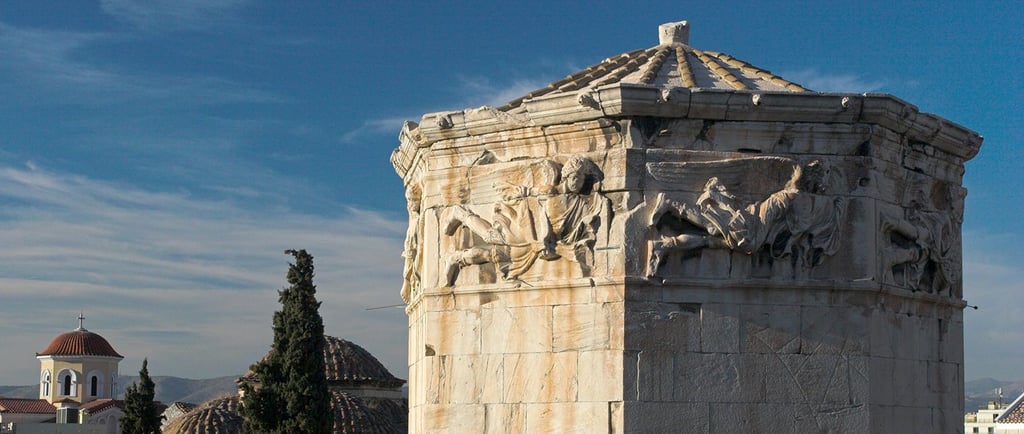The Tower of the Winds 🏛️Ancient Timekeeping⏳
Stories About Time: Measuring Moments Through History ⏳🌞🌕 from the chapter "Towards an Understanding of Linear Time" from the History Album. In this chapter we invite children to a journey through the fascinating evolution of timekeeping. Starting with observing the Sun🌞, and people who first noticed the movement of shadows to mark the day, to the people who noticed the phrases of the Moon 🌙, and tracked the lunar cycle to create months, these stories uncover humanity’s inventive ways of measuring moments.Children will marvel at ancient innovations, like sundials and lunar calendars, and explore cultural contributions, such as candle clocks 🕯️ and water clocks 🌊, that paved the way for modern timekeeping. Each story weaves history, science, and culture, showing how humans connected with the natural world to organize their lives. 🌿✨Through these narratives, children will see time not just as a number on a clock, or passing month on the callendar, but as a rich legacy of human curiosity and creativity. With hands-on activities like building sundials and journaling moon phases, they’ll become modern-day timekeepers, inspired to ask, “How did people measure time before clocks?” and “What can I discover about time?”This vivid exploration links the past to the present, sparking imagination and a deeper appreciation for the ingenuity of those who came before us. 🌍✨
HISTORY STORIES
12/11/20243 min read


Do you remember how water clocks 🌊 helped people tell time when the sun 🌞 wasn’t shining and how sundials 🕶️ tracked shadows during the day? These tools were incredibly useful, but the Greeks had an amazing idea. "Wouldn’t it be amazing if we could combine them all in one place?" The Greeks 🇬🇷 thought so, and in Athens, they built something extraordinary: the Tower of the Winds! 🏛️✨
The Tower of the Winds, created around 50 BCE, was one of the world’s first clock towers. This magnificent, eight-sided marble structure stood tall in ancient Athens, glittering in the sunlight ✨. Each side of the tower faced a different cardinal direction (north, south, east, west, and the directions in between). On each side, there was a sundial 🌞⏱️ engraved into the stone. As the sun moved across the sky during the day, the shadows would fall on the appropriate sundial for that time.
No matter where the sun ☀️ was in the sky, there would always be at least one sundial catching its rays and showing the correct time. In this way, the Tower of the Winds provided a full-day solution to track time outdoors!
But what happened at night 🌙 or on cloudy days 🌧️ when the sun wasn’t shining? Inside the Tower, the Greeks added a water clock ! Flowing water turned gears ⚙️ that moved ropes, showing the time.Something like this.The water clock worked perfectly even when the sky was dark or overcast.
At the very top of the Tower, there was another incredible feature: a wind vane 🌬️ made of bronze, shaped like Triton, the sea god 🧜♂️. This device pointed in the direction of the breeze, showing Athenians where the wind was coming from. Each side of the Tower was decorated with a carving of a wind god 🌪️, representing the eight directions of the wind coming from the greek mythology. The Gentle East wind, associated with warm weather and crops. 🌞 The Mild West Wind was bringing spring and early summer. 🌸South Wind was bringing a lot of rain in his big vessel.🌧️ The North wind was bringing the cold wind from the north and the winter. ❄️I wonder what the other 4 winds were associated with?
Imagine standing in front of the Tower of the Winds on a sunny day 🌤️, watching the sundial cast its shadow. Then, as clouds roll in ⛅, you could step inside to check the water clock ticking away the time. And if a breeze blew past, Triton’s bronze wind vane would point the way.
The Tower of the Winds measure time and showed from where the winds were blowing and maybe this helped people predict the weather. It combined sundials🌞, water clocks 🌊, and wind vanes 🌬️, making it a central place where people could organize their day. It wasn’t just a clock—it was a scientific masterpiece! 🏛️✨
A s amazing as the Tower of the Winds was, it was still a large structure that people had to visit to tell time. What if you needed to measure time indoors, at night, or in a way that could even wake you up? People began to wonder: Could fire, humanity’s oldest companion, become a timekeeper too? 🔥 That’s when someone had the idea for the candle clock, a glowing invention that changed the way people measured time.
But that’s a story for another day… 🕯️✨
This story is part of the following Clock Stories Series which can be turned into Drama Play or Storybook Compilation.
Ancient Timekeeping
🌞 The Sun Watchers ~3500 BCE
🌊 The Water Clock Wonders ~1500 BCE
🏛️ The Tower of the Winds ~50 BCE
Medieval Timekeeping
🕯️ The Candle Clock ~980 CE
🌌 Su Sung’s Astronomical Water Clock ~1092 CE
⏳ The Hourglass Sand Masters ~14th Century
🛎️ The Mechanical Church Bells Chime ~14th Century
Science in Timekeeping
🌟 Astronomical Marvel: The Prague Clock ~1410 CE
🌍 Galileo’s Pendulum Discovery ~1602 CE
🕰️ Pendulum Perfection ~1656 CE
Modern Timekeeping
🌊 Marine Chronometer ~18th Century
⏱️ The Quartz Revolution ~1920s CE
With Montessori joy,
Vanina 😊

